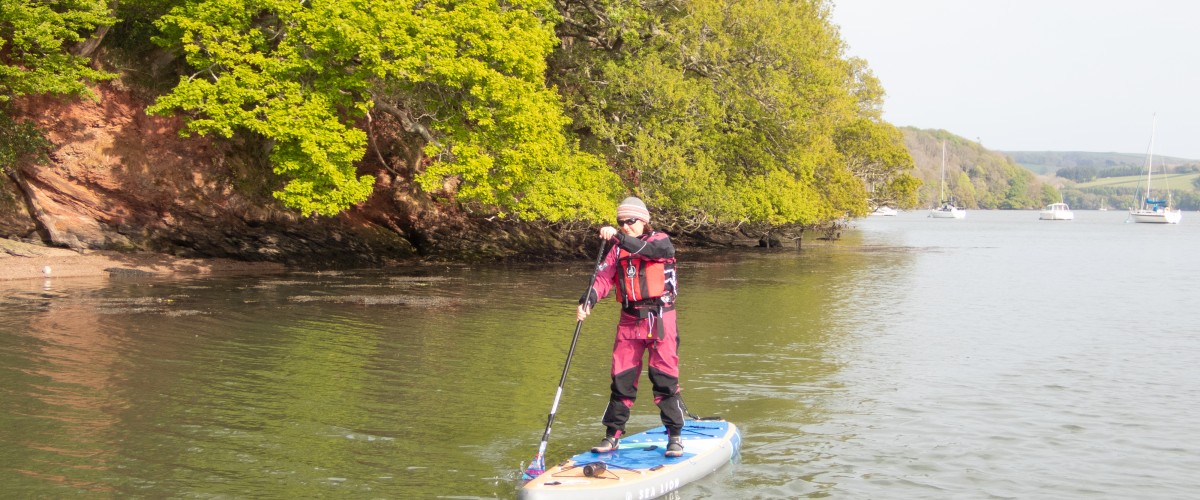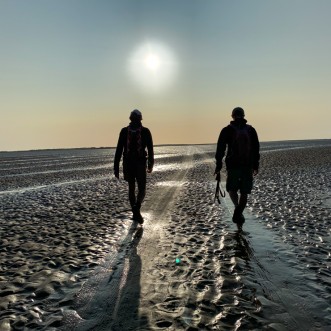With so many great rivers to paddle board on in the UK, here are our top tips for staying safe, looking after the environment and maximising your enjoyment.
• Always wear a personal flotation device (PFD) and a quick release leash when paddleboarding.
• Always check river water levels and water flow speed before you enter the water. Before setting off plan ahead for sluices, weirs, bridges, locks and recent heavy rains as they can all affect local water speed. Once you get to the river check for turbulence on the surface, a strong clue that the flow is quick. Anything over 4 knots (nearly 4mph), which is a very brisk walking speed, is inadvisable to enter unless you are experienced in these conditions.
• Floodwater increases the speed of the flow, adds unexpected currents and can hide a multitude of dangers like rocks, tree stumps and shopping trollies just under the surface, waiting to snag your fin. Always check online for water depth information and avoid the waterway if above normal levels.
• In low water conditions or shallows below 3ft (1m) always drop to your knees on the board to avoid falling into if you run aground.
• A typical river will have large variations in flow depending on the shape of the riverbed, including obstacles, whether the river is getting deeper or shallower, and whether the river is straight or meandering. Generally the sections that move slower are near the shore, especially along the inside edge of a curve. This is important to know when paddling upstream where paddling will be easier closer to the shore, and when the river bends the opposite direction it might be worth crossing over. The shore is also where you are likely to encounter eddy currents, where the flow is generally upstream. The fastest flow is generally on the surface in the middle of a river, water on the bottom though will be slowed by drag on sand and rocks, just as it is in the shallow water near the shore.
• Obstacles in rivers and canals can create specific flows that need to be assessed in planning, especially weirs on your route where you need to know where to exit the water and how to portage around them. Same for locks on canals. Bridges with stanchions in the water, along with other large obstacles, will create restrictions and resultant faster flows and eddies that you also need to be aware of. Look out for hidden hazards like lines, chains and ropes near boat moorings.
• Licence and permits – a Waterways Licence is required for kayaks, paddle boards and canoes on canals and rivers managed by the Canal and River Trust, Environment Agency and Broads National Park. Fines of £1000 may be administered if the paddler is found without one/not displaying one. There are numerous options for day and annual licences from a number of issuing bodies which can be confusing. The waterways requiring a licence are listed on the British Canoeing Website and the GoPaddling app. Annual permits are issued by British Canoeing or the Water Skills Academy. Some private lakes and Harbour Authorities require a permit that is not covered by the above, these can be purchased locally or online. They will require liability insurance, so if you are not a member of BCU or WSA you will have to arrange separately.
• Biosecurity – there are over 50 non-native invasive species in UK waters that paddlers may encounter. Many of them wreak havoc across our rivers, lakes, canals and other waterways with detrimental impacts on indigenous British species and ecosystems. Some can change the whole ecology of a water body. The four of the most prolific INNS are killer shrimps, floating pennywort, signal crayfish and giant hogweed. These species can survive in damp clothing, get caught around rudders, stick to the surface of craft or get stranded in puddles at the bottom of poorly drained canoes. British Canoeing recommends adopting a clean-check-dry biosecurity procedure of your craft and clothing to halt the movement of such undesirable species. More information on the species and how to minimise transmission at Go Paddling here.
• Entry/exit points of a river – avoid dragging boats on river banks and damaging local wildlife habitat. Also avoid dragging boards over and standing on gravel beds, as they may be important spawning grounds for fish. Further information in the British Canoeing and Natural England “Paddlers’ Code”.
• River fins – shallower water, summer weeds or rocks in the river may mean that the larger central fin needs to be replaced with a shorter fin. Many river fins are also more flexible, so if they do get caught in something they help avoid damage to the fin box and fin.
• Swans – move away from them or exit the water so that they can pass. Males are generally more aggressive when defending their nests during the spring nesting season – April to June.
• Anglers – give them as wide a berth as possible and watch out for their fishing lines.
• Watch out for waterbourne diseases. Weil’s Disease (Leptospirosis) infects through cuts or abrasions of the skin or, the lining of the nose, mouth, throat or eyes. If flu-like symptoms develop 1 – 3 weeks after contact with water consult your GP. Blue-green algae (cyanobacteria) are commonly found in fresh and brackish water during mid to late summer, particularly during long periods of warm, settled weather. The blooms produce allergens and/or toxins which can cause eye irritation, dermatitis and joint/muscle pain and more serious symptoms. The risk of gastrointestinal illness from inland and coastal waters depends on the number and proximity of sewage effluent discharges. Surfers Against Sewerage Safer Seas and River Service provides an app provides information on the latest pollution incidents – see here , as does The River Trusts app. This is also important for avoiding Hepatitis. Beware also of other agricultural and industrial pollutants too that may be harmful to health. Generally if the water looks or smells bad there is a likelihood of pollution and the potential to cause ill health. More information and how to avoid illness at Go Paddling
• Usual stuff – don’t forget to always tell someone where you are going and your return time, take your phone in a waterproof pouch, check the weather, plan around the obstacles like weirs and locks, wear a suitable flotation device, dress for the water temperature, wear an quick release belt leash on a flowing river, get the appropriate level of training
WHAT TO DO IN AN EMERGENCY – on inland waterways in an emergency call 999 and ask for the Fire and Rescue Service


